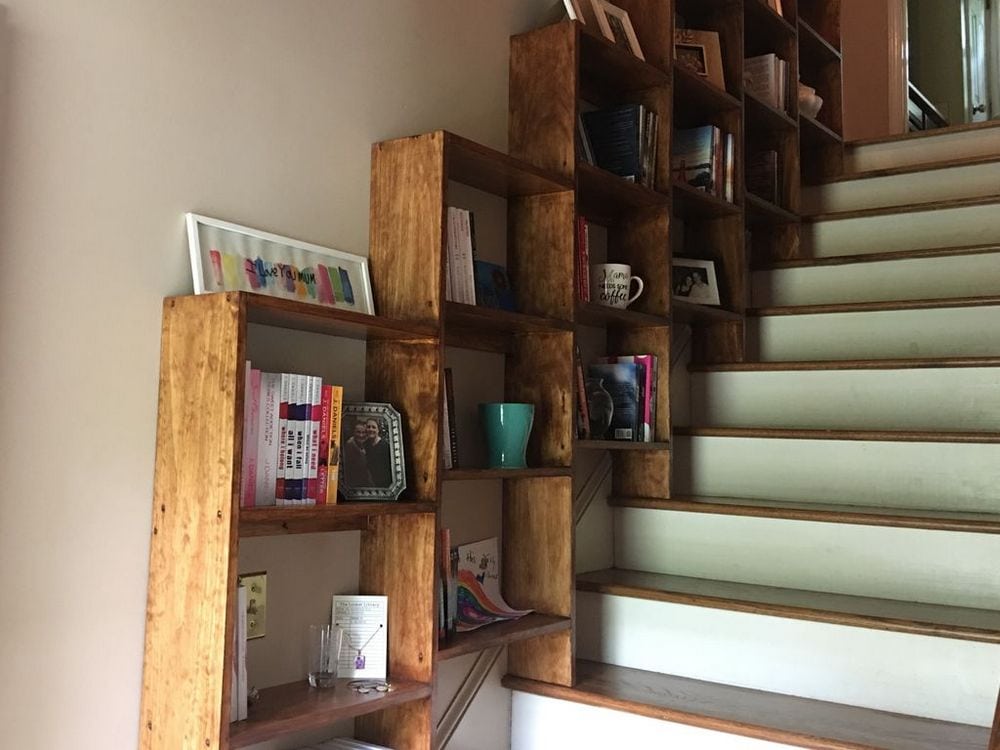
Make good use of that empty stairway space and build a staircase bookshelf in them!
Despite the availability of e-books, a lot of people still opt to buy paperbacks or hard-bound ones. There’s something satisfying about the smell of a book and being able to actually flip the pages.
My mother is a wide reader and she somehow influenced us to become book lovers as well. Actually, we still have rows of cabinets full of books in our house, even after donating some to the school library.
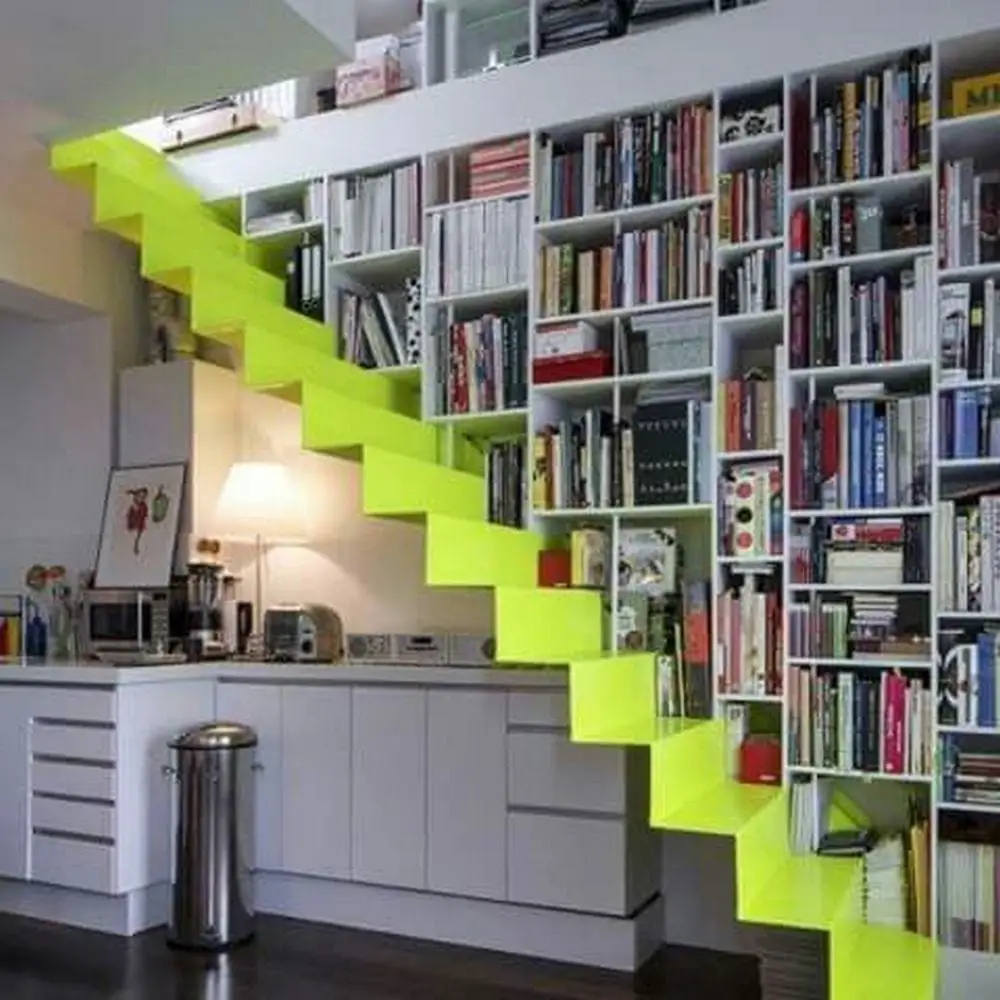
One of our dilemmas, though, is not having enough space for books. We also know that we won’t stop buying them anytime soon. We were already throwing suggestions here and there, deciding where to place the books. It was when my sister suggested that we make use of the wall beside the staircase. We searched if it is doable and, luckily, it is! Problem solved with this staircase bookshelf!
Contents
Building a Staircase Bookshelf
Materials
- (11) pine boards 3/4″ thick x 7 1/2″ wide x 96″ long.
- (72) #6 x 1 5/8″ long wood screws
- (8) #8 x 2 1/2″ long wood screws
Tools
- Cordless circular saw
- cordless drill with drill bits and Phillips bit
- rafter square
- measuring tape
- bevel gauge
- coping saw
- a hobby rasp
- clamps
- profile gauge
- sandpaper
- wood glue
- wood stain and sealer
- saw horses to work on
Instructions
Preparation
- Design and Planning: Measure the space beside your staircase to determine the size of your bookshelf. Sketch your design, noting the number of shelves and their spacing. Ensure the design fits the available space and meets your storage needs.
- Safety Gear: Before starting, wear safety glasses and gloves to protect yourself during the work.
- Material Preparation: Lay out the (11) pine boards on saw horses. Mark the dimensions of the shelves and sides according to your design using the measuring tape and a pencil.
Cutting
- Cutting Shelves and Sides: Use the cordless circular saw to cut the pine boards to your marked dimensions. For angled cuts that match the slope of your staircase, use the bevel gauge to mark the angles before cutting.
- Cutting Notches (if required): If your design includes notched shelves for a more integrated look, use the coping saw for precision cuts. Clean up the notches with a hobby rasp for a snug fit.
Assembly
- Dry Fit: Arrange the cut pieces on the floor to ensure they fit together well. Make adjustments as necessary.
- Drilling Pilot Holes: To prevent the wood from splitting, use the cordless drill and drill bits to make pilot holes for the screws at each joint.
- Assembling the Frame: Start by attaching the sides to the top and bottom shelves using the #8 x 2 1/2″ long wood screws. Ensure everything is square using the rafter square.
- Attaching the Shelves: Attach the remaining shelves at the desired intervals using the #6 x 1 5/8″ long wood screws. Use clamps to hold the shelves in place as you work. Ensure each shelf is level before securing.
- Reinforcement (optional): For added stability, you can apply wood glue at each joint before screwing the pieces together. Wipe away any excess glue with a damp cloth.
Finishing
- Sanding: Once the bookshelf is assembled, sand the entire structure with sandpaper to smooth out rough edges and surfaces. Start with a coarse grit and move to a finer grit for a smooth finish.
- Staining and Sealing: Apply wood stain to give your bookshelf a finished look. Use a brush or rag to apply the stain, following the grain of the wood. After the stain has dried, apply a sealer to protect the wood.
- Installation: Position the bookshelf beside your staircase. If necessary, secure it to the wall with brackets for additional stability.
Final Touches
- Decorating: Arrange your books, plants, and decorations on the shelves. Adjust the placement to create a balanced and aesthetically pleasing display.
Design Considerations for Staircase Bookshelves
Designing a staircase bookshelf requires thoughtful consideration to ensure that the final product is both functional and aesthetically pleasing. This unique storage solution can transform an overlooked area into a dynamic and engaging part of your home, marrying practicality with design flair.
Here are the key design considerations to keep in mind when planning your staircase bookshelf.
Space Utilization
Evaluate the space around your staircase to determine how a bookshelf can best fit. Consider the width, height, and depth of the potential bookshelf area. A well-designed staircase bookshelf should optimize unused spaces without obstructing the staircase or surrounding areas.
Design Compatibility
The style of the staircase bookshelf should complement the existing interior design and architecture of your home. Whether your decor is modern, traditional, or eclectic, the bookshelf can be designed to enhance the overall aesthetic.
Structural Considerations
Safety is paramount. The design must ensure that the bookshelf is structurally sound and does not compromise the integrity or safety of the staircase. It should be securely anchored to prevent tipping or collapsing.
Material Selection
The materials used for the staircase bookshelf should not only be aesthetically pleasing but also durable and suited to the weight they will bear. Consider the type of wood or alternative materials that will best match your design vision and practical needs.
Accessibility and Functionality
Shelves should be easily accessible, taking into account the height and reach of potential users. Consider creating varying shelf heights to accommodate different book sizes and other items you wish to display.
Lighting
Good lighting is crucial for both the functionality and ambiance of the staircase bookshelf. Integrated lighting solutions can highlight your books and decorative items, making them easy to find and adding to the overall aesthetic.
Custom Features
Think about adding custom features that reflect your needs and personality. This could include built-in seating areas, hidden compartments, or specific areas designed for art displays.
By keeping these design considerations in mind, you can create a staircase bookshelf that is not only a smart storage solution but also a statement piece in your home. A well-planned staircase bookshelf can enhance the beauty and functionality of your living space, making it a source of pride and enjoyment.
Click on any image to start the lightbox display. Use your Esc key to close the lightbox.

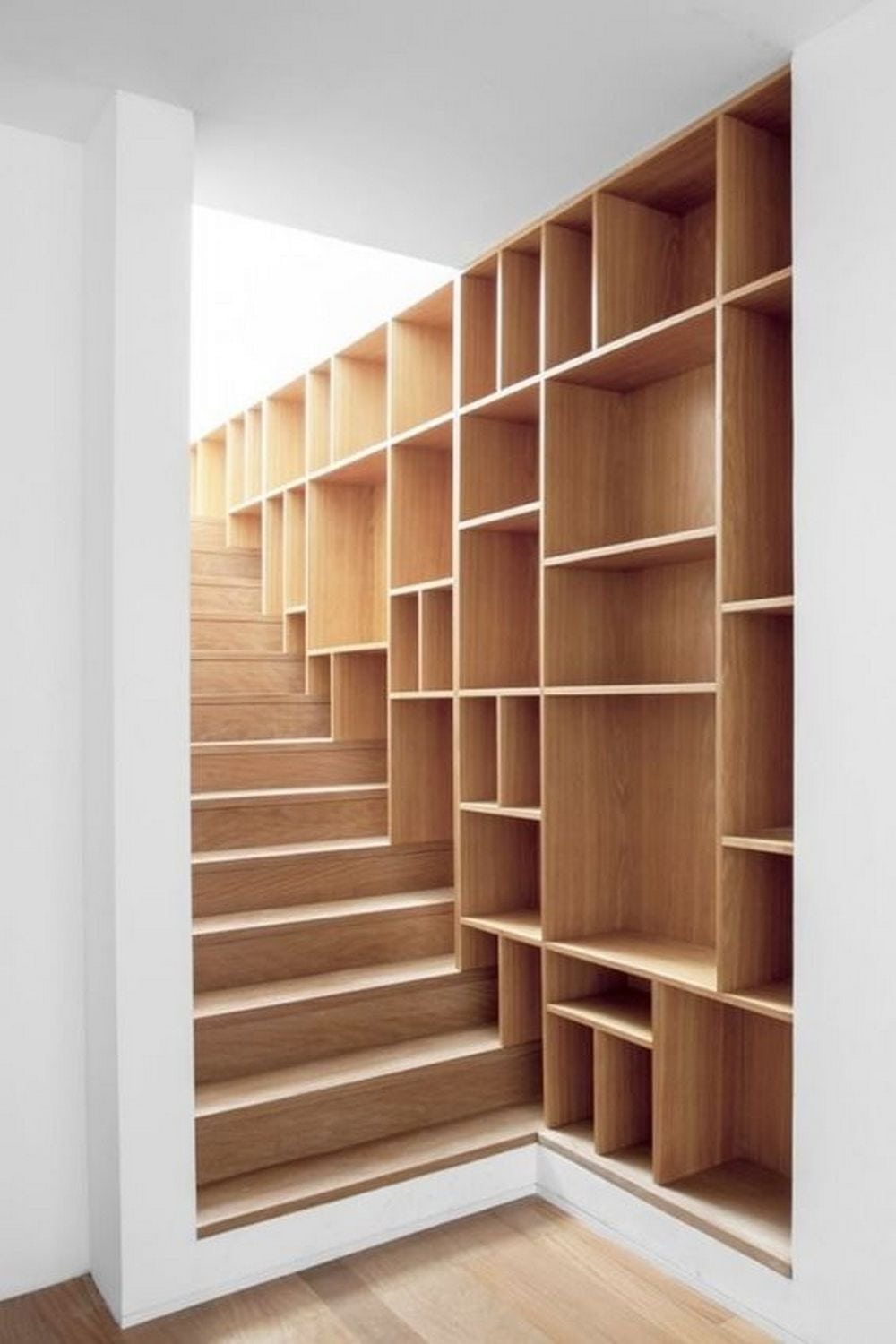



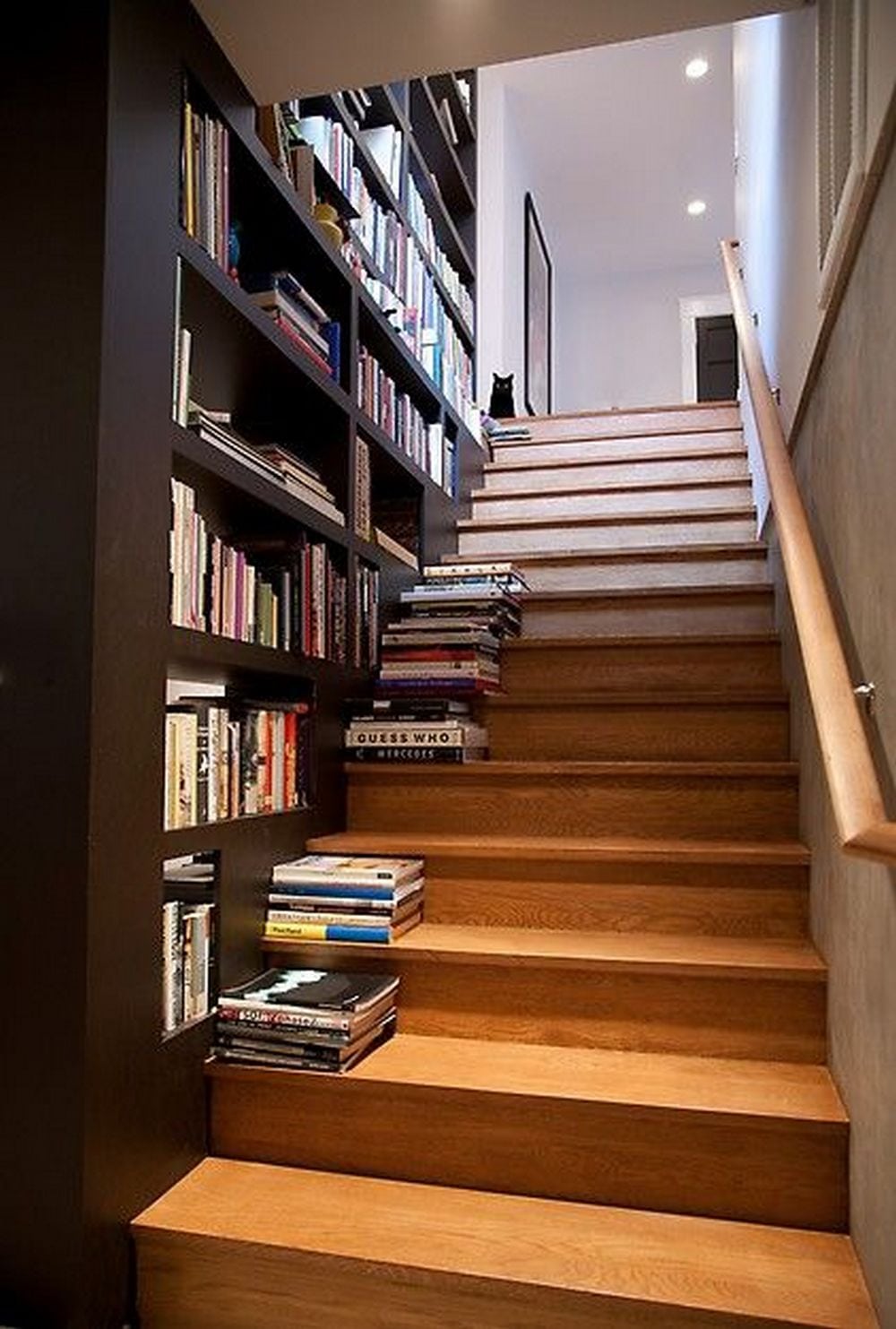
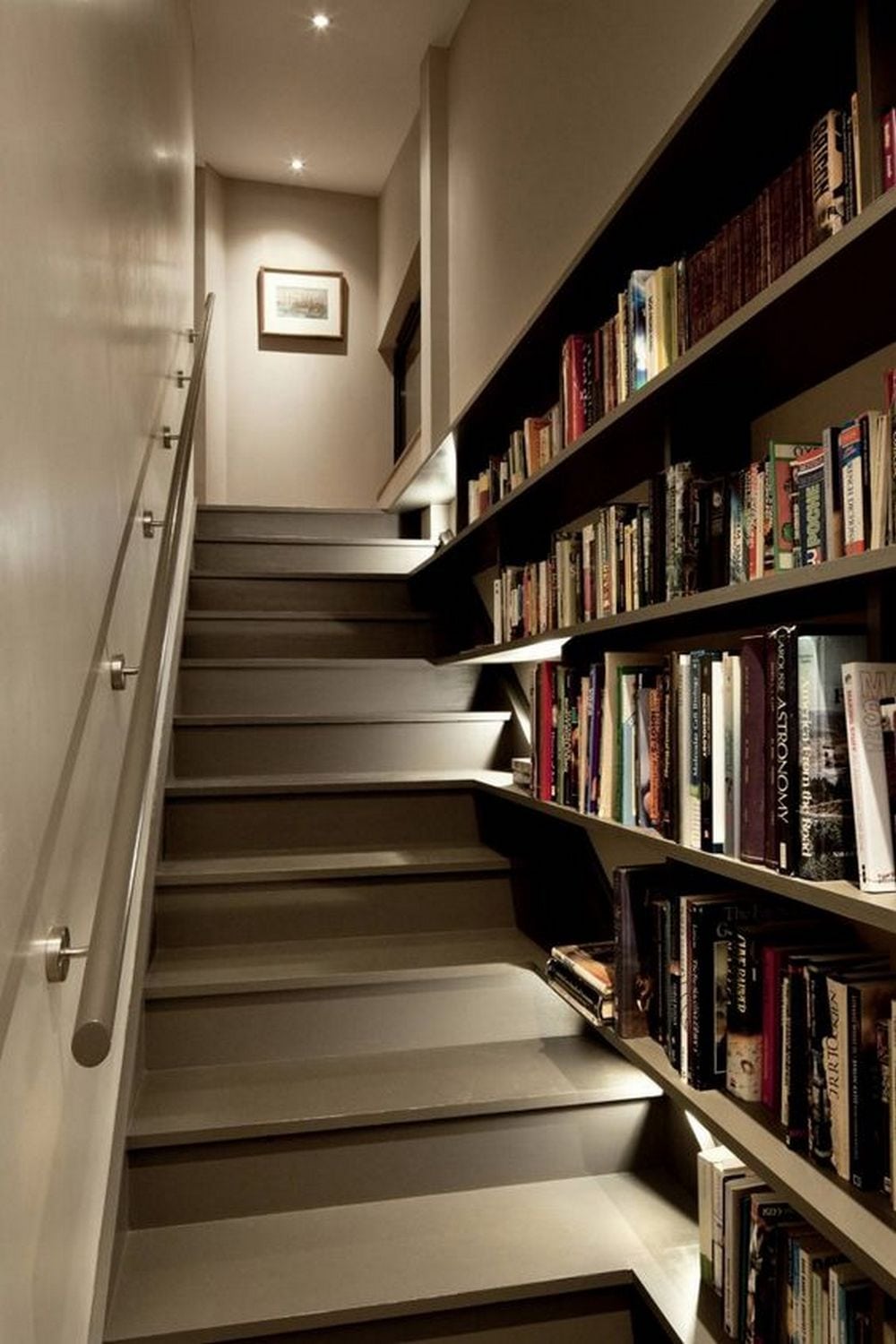
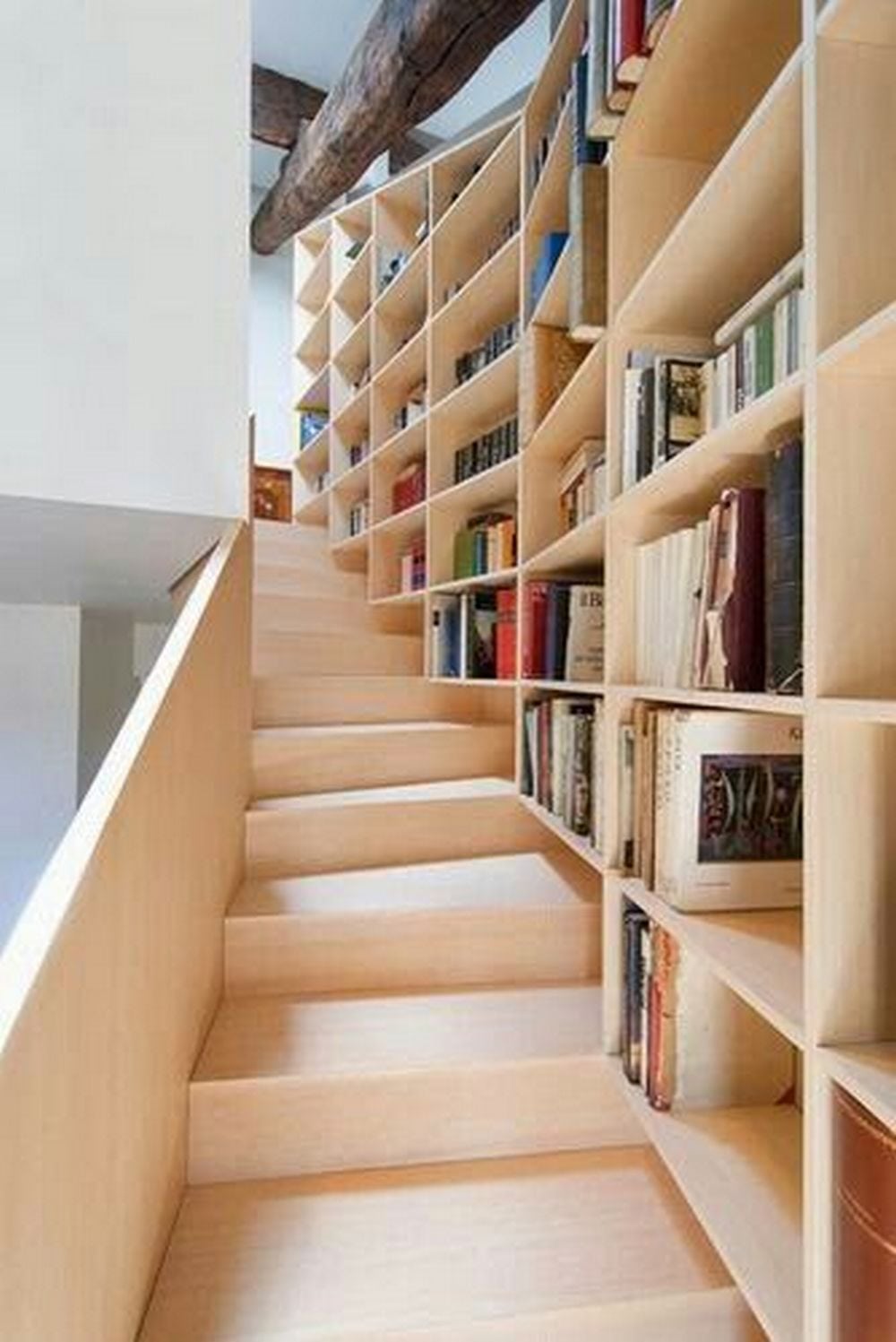

Safety Tips and Best Practices
Creating a staircase bookshelf is an exciting project that combines functionality with aesthetic appeal, transforming an ordinary space into a striking feature of your home. However, it’s crucial to prioritize safety and adhere to best practices throughout the construction process to ensure a durable and secure outcome.
Below are essential safety tips and best practices to consider when building your staircase bookshelf.
Planning and Design
Before embarking on the construction of a staircase bookshelf, a thorough evaluation of the structural integrity surrounding your staircase is crucial. This step involves inspecting the walls and any adjacent spaces for their ability to bear additional weight.
It’s essential to consider the materials these structures are made of and any potential impact your project might have on the staircase’s stability. For example, if the wall is load-bearing, adding a bookshelf will require careful planning to avoid compromising the home’s structural safety.
Consultation with a structural engineer or a knowledgeable carpenter can provide insights into the feasibility of your plans and any necessary precautions. This proactive approach ensures that your staircase bookshelf is not only an attractive addition to your home but also a safe and functional one.
Tool Safety
The foundation of a successful DIY project lies in the proper use and handling of tools. Before you begin constructing your staircase bookshelf, take the time to acquaint yourself with each tool you plan to use.
This involves more than a cursory glance; it requires reading the manufacturer’s instructions comprehensively to understand the tool’s capabilities and limitations. Safety gear is non-negotiable—gloves protect your hands from splinters and abrasions, while eye protection shields against dust and flying debris.
Additionally, ear protection is advisable when using loud power tools to prevent hearing damage. Knowing how to correctly operate your tools not only ensures your safety but also contributes to the quality of your work, resulting in a more polished and durable staircase bookshelf.
Material Handling
The materials used in building a staircase bookshelf, particularly large and heavy boards, pose potential risks if not handled correctly. Employ safe lifting techniques to avoid back strain or injury; this includes bending at the knees and keeping the load close to your body.
A clean and organized workspace is critical to preventing accidents such as trips and falls. Before making any cuts, ensure that your materials are securely positioned, either clamped down or supported adequately to prevent movement.
This not only safeguards your safety but also ensures precision in your work, leading to a better-constructed staircase bookshelf. By adhering to these material handling practices, you mitigate risk and enhance the efficiency and enjoyment of your DIY project.
Installation Safety
When installing a staircase bookshelf, the paramount concern is ensuring that the entire structure is securely anchored. This is critical not only for the stability of the bookshelf but also for the safety of those who use it.
To achieve a secure mounting, select fasteners and brackets that are suitable for both the weight of the bookshelf and the types of materials it is being attached to. For example, mounting on drywall will require different anchors than mounting directly into studs. After installation, make it a routine to inspect these connections periodically.
Changes in temperature and humidity can cause materials to expand and contract, potentially loosening fasteners over time. A regular check ensures that your bookshelf remains as stable as the day it was installed, safeguarding against accidents related to tipping or collapsing, which are especially crucial in high-traffic areas like staircases.
Electrical Considerations
Integrating a staircase bookshelf often involves modifying existing structures, including drilling into walls for mounting. This step requires caution due to the potential presence of electrical wiring within these walls. Accidentally drilling into electrical wiring can lead to serious safety hazards, including electrical shock or even causing a fire.
To mitigate these risks, using a stud finder equipped with an electrical detection feature is advisable. This tool can help locate studs for secure mounting while also alerting you to the presence of electrical wires. If you detect wiring in your planned drilling area, either adjust your installation point or consult with a professional electrician.
An electrician can advise on the safest course of action, potentially rerouting wires or confirming safe areas to drill. This precaution not only protects your physical safety but also ensures that your home’s electrical system remains intact and functional.
Childproofing
When integrating a staircase bookshelf into a home with children, prioritizing safety in the design is crucial. Children are naturally curious and may attempt to climb or pull on the bookshelf, posing a risk of injury or accidents.
To avoid these risks, focus on designing the bookshelf with rounded edges and corners. Childproofing can be achieved during the finishing phase, where sharp edges are smoothed out to prevent scratches or more serious injuries if a child bumps into them.
Additionally, the layout of the shelves should be planned to deter climbing. Shelves that resemble steps or ladders may invite adventurous attempts to ascend them, so consider a design that discourages such activities. Placing heavier items on lower shelves and securing the bookshelf firmly to the wall can also prevent it from tipping over. These precautions ensure the staircase bookshelf is a safe addition to your home, offering peace of mind alongside functionality and style.
Regular Maintenance
The longevity and safety of your staircase bookshelf depend significantly on regular maintenance and inspections. Over time, the structure may be subjected to wear and tear that can compromise its stability. To prevent any safety hazards, it’s important to periodically check the bookshelf for signs of damage, such as cracks in the wood, loosening fasteners, or any other structural weaknesses.
Pay particular attention to the anchor points where the bookshelf is secured to the wall, as these are critical for stability. If any issues are detected, address them promptly to prevent further damage or potential accidents. Regular maintenance not only extends the life of your staircase bookshelf but also ensures it remains a safe storage solution for your home.
Professional Advice
Building or modifying a staircase bookshelf involves several considerations, from design and installation to ensuring it complies with building codes and safety standards. If at any point you face uncertainties about structural issues or the overall feasibility of your project, seeking professional guidance is advisable.
A qualified carpenter or structural engineer can assess your plans and provide expert advice on how to proceed safely and efficiently. They can help identify potential problems you may not have considered.
Carpenters can also suggest solutions to ensure your staircase bookshelf is not only aesthetically pleasing but also structurally sound and integrated seamlessly into your home’s design. Consulting with professionals can save time and money in the long run, ensuring your project is completed to the highest standards of safety and quality.
These safety tips and best practices give you confidence in building a staircase bookshelf that is not only a visually appealing addition to your home but also a safe and enduring one. Always prioritize safety throughout the construction process to protect yourself and others who enjoy the space.
Material Selection Guide
Choosing the right materials is a critical step in creating a staircase bookshelf that is both beautiful and durable. The materials you select will influence the bookshelf’s appearance, functionality, and longevity.
This guide will help you navigate through the options and considerations for selecting the best materials for your staircase bookshelf project.
Wood Types
Hardwoods, such as oak, maple, and walnut, are known for their durability and resistance to wear and tear, making them ideal for a bookshelf that will see frequent use. Softwoods, like pine, are more budget-friendly and easier to work with but may not withstand heavy use as well. Consider the balance between cost, appearance, and durability when choosing the wood type.
Plywood and Engineered Woods
Plywood and engineered woods like MDF (Medium Density Fiberboard) can be cost-effective alternatives to solid wood. They offer a uniform appearance and are less prone to warping. However, they may not have the same natural beauty or longevity as solid wood. These materials are suitable for a staircase bookshelf if you’re looking for a more affordable option or planning to paint the finished piece.
Finish and Treatment
The finish you choose will affect the bookshelf’s final look and its resistance to damage from sunlight, moisture, and everyday wear. Stains can enhance the natural beauty of wood, while paints can provide a uniform color and additional protection. A sealer or topcoat will help preserve the finish and protect the wood from moisture and scratches. Consider the overall design of your home and the level of durability you need when selecting finishes.
Fasteners and Hardware
The right fasteners are crucial for assembling your staircase bookshelf securely. Wood screws, brackets, and anchors should be chosen based on the weight they need to support and the type of wall you’ll be mounting the bookshelf on. Ensure the fasteners are suitable for the material of your bookshelf and the wall to prevent damage and ensure stability.
Eco-Friendly Options
If sustainability is a concern, look for wood sourced from responsibly managed forests, certified by organizations like the FSC (Forest Stewardship Council). Reclaimed wood is another eco-friendly option that can add character to your staircase bookshelf while reducing environmental impact.
Consider the Space
Consider the materials already present in the space where the staircase bookshelf will be installed. Matching or complementing the existing materials can help integrate the new bookshelf seamlessly into your home’s aesthetic.
Selecting the right materials for your staircase bookshelf is about balancing aesthetics, durability, and budget. By carefully considering each option, you can create a functional, beautiful piece that enhances your space and lasts for years to come.
Conclusion
Building a staircase bookshelf offers a creative solution to maximize underutilized space, adding both aesthetic appeal and functional storage to your home. It provides an opportunity to display books and decor in an organized manner, enhancing the overall ambiance of your living space. Additionally, this project can increase the value of your home through a custom feature that blends practicality with personal style.






